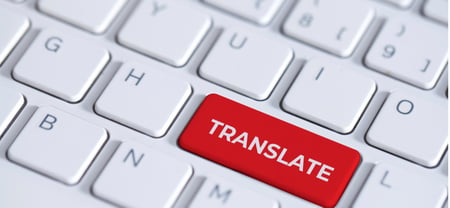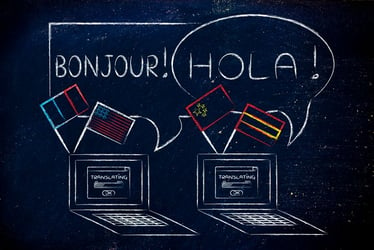
As you scale your operations, ensuring your website—your digital storefront—communicates effectively with your audience becomes paramount. How much will it cost to translate and localize your website content to resonate with various demographics?
While there isn't a straightforward answer, multiple factors contribute to the final cost of website translation. At LinguaLinx, we understand the vital role websites play in crafting a lasting impression on potential customers.
In a world where only 5% of the population speak English as their first language, as reported by The Washington Post, engaging with a global audience means adapting to their linguistic and cultural nuances.
This article explores the key elements that affect website translation costs. Armed with this knowledge, you'll know what critical questions to ask when considering a digital translation project, emphasizing the significance of precision and localized content.
What Type of Resources Do You Need?
What kind of expertise are you looking for? How much do you know about the market you’re moving into? Enough to project manage the website translation, so you only need to hire a translator?
Or do you need a Language Service Provider (LSP) that can guide you through all the obvious, and not-so-obvious, potential pitfalls to make the project come in on time and on budget?
By answering these questions, you’ll be putting your company in the best position to grab market share in your new territory.
Machine Translation vs Professional Translation
Machine translation (MT) is exactly what it sounds like. You put the words in one language at one end and they come out on the other side translated into your target language.
How accurately? It depends on how much you spend on the MT, the complexity of the copy going in and the source and target languages.
Machine translation is fairly cheap, you can get plugins for less than $100, but unless you have someone doing some serious post-editing and proofreading, you could end up looking less professional than you’d like.
Professional translation is where you partner with an LSP and they guide you through the process. They quote and then take care of everything, making sure you’re comfortable every step of the way.
Yes, it costs more than MT, but you’re getting more than just translation, you’re getting a localization service.
Will You Pay Per Hour, Per Word, or Per Project?
The text translation fees for websites are usually charged by the hour or by word count.
Human translation ranges from about $0.08 to $0.25 per word depending on the complexity of the content and languages.
For most common languages, the cost per hour ranges from $17 (Spanish) to $30 (French).
Or you can get a full quote, which will probably consider one of these two routes within it, and know where you sit because you’re budgeting for the entire project which includes all of the little incidental options that maybe you wouldn’t have considered.
What is Your Industry?
The type of work your company does will greatly influence how much you'll need to spend on translating your website. Some industries have special words and terms that are harder to translate.
For example, companies in the law, health, and technology sectors usually use many complex words and terms. Translating these can be trickier than for companies in simpler industries like marketing or those that sell products.
Think about how many special words your company uses. Can these be easily translated? Also, remember that if you're in a particular industry, some of your content may need to be checked and approved by certain government or industry bodies before it can appear on your website.
Knowing this can help you better plan your website translation project.
How Quickly Do You Need Translation?
There’s the age-old adage that the faster you need something, the more it’s going to cost, especially if you can’t afford to sacrifice accuracy…and, by the way, you can’t afford to sacrifice accuracy.
Can you put a smaller team on it over a longer period of time? Or do you need to pay for a lot of resources because you’re moving into a new market quickly?
Or maybe you’re working in a hybrid of the two. This is where project management comes into play. Having a supplier that is used to create the right workflow gives you the flexibility to scale up at pace.
How Big is Your Website?
Size matters. You’ll probably be working on a rate per hour of translation or per word, so every word counts.
Is your website copy-heavy?
Has it grown organically over the years and now might be a good time to have an audit to see if there is any info that is unnecessary, outdated, redundant or that your web stats shows it doesn’t get traction with people?
Rather than translate this information, get it right (and lean) in English first before you start spending money on translating it into other languages.
How Many Languages Will You Translate Your Website into?
It’s an obvious question, but how many target languages do you need?
The more languages, the higher the cost because you need more translators involved.
So, the question to ask is maybe not how many potential target languages are there, but how many do you need to address in the first instance to gain traction in that market?
For example, there are ten major Spanish dialects; you could have a separate version of your website for each one, but would you get enough value for that investment? Or is it better to go down a more mainstream route, using traditional Spanish, until the need is there to drill down further?
A fraction of the cost with almost the same market penetration.
Which Languages Will You Translate Your Website Into?
Are we talking about fairly standard European languages (German, French, Spanish, Italian, Polish, etc.) where the alphabetical character set remains similar?
Or are you heading into an Asian, African or Middle Eastern market that has its own set of characters? Will this impact the design of the site (which can trigger costs) or the User Experience (UX)?
For example, if you’re making a website in Arabic, you have to consider that the language is read right to left and not left to right like English.
As with all translations, the rarer the language, the more it will cost.
What Forms of Media are on Your Website?
Today, media-rich websites tend to outperform those that just rely on copy. Is your website only text and images? Is it only the text that needs to be translated? Or are there videos, audio, infographics, charts and other media to translate that should be considered in the budget?
It might not just be the text in images that makes them need to be localized to a new market. Maybe you’re going into a Muslim country and you have images that are not modest enough for the teachings of the Quran. You’ll need to source new images that respect the culture while maintaining your brand.
Are all of Your Links Going to Work?
Do you link to social media accounts? If you’re localizing into China forget Facebook, Instagram, WhatsApp or LinkedIn (although LinkedIn has launched their InCareer app for mainland China that the South China Morning Post says is “Tailored for China, which has strict requirements on content censorship and data protection”).
You need to create a version of your site without these on or risk alienating your audience by showing ignorance of their business culture.
Get a Quote for Your Website Translation Project
As you can tell, there are a lot of factors to consider when putting a budget together for a website translation program, and there’s no easy answer to, “how much does a website translation project cost?” So what’s our best advice? Use a Language Service Provider.
They’ll ask all of the questions needed and cover all the topics in this blog post to develop an accurate, water-tight quote.
You want a one-stop shop that has successfully delivered website translation projects time and time again.
Website translation is just one part of what we offer our clients at LinguaLinx, so if you want to know more we’d love to talk to you.
With LinguaLinx, you won't ever have to worry about your message getting across. You know you're in good hands with our ISO 17100 and ISO 9001 compliance, twenty years of professional translation experience, and the organizations whose trust we've earned.






